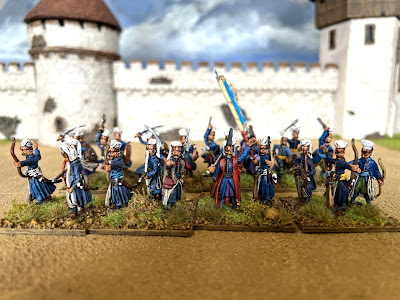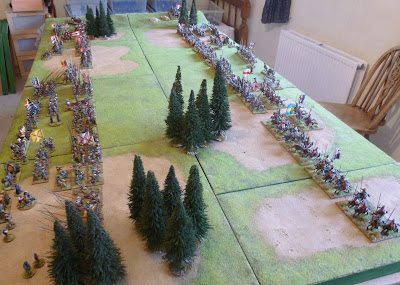Today's post sees a return to the Ottoman army with some more janissaries. The figures are from the excellent Warfare Miniatures Ottoman Turkish range. The range represents the janissaries of the 17th and 18th centuries but as these particular figures are armed with bows or swords and shields they also work well for the 16th century. I have tweaked some them a little to make them more suitable for the 1500s but there are no great changes to the miniatures. As discussed in my original post on the janissaries,
https://camisado1500s.blogspot.com/2020/05/early-16th-century-janissaries.html, it is difficult to know how they looked on campaign during the first half of the sixteenth century. I have serious doubts as to how much of the "classic" janissary uniform would have been worn on campaign, included the famed "ak börk" or "bork" white caps, and how uniformed they would have been.
Further to this, having recently read a translation of Konstantin Mihailovic's account of the Ottoman army in the second half of the 15th century I thought it would be interesting to include his description of how the janissaries were organised in the post. Whether or not he was actually a janissary seems up for debate, he may have been some kind of Serbian auxiliary providing support to the janissary corps. Writing between 1490 and 1500 his chapter concerning the organisation of the Imperial court describes the janissaries as such:
"And at the court there are about four thousand Janissaries, and among them there is the following organisation. They have over them a senior hetman called an aga, a great lord. He receives ten gold pieces a day, and his steward, one gold piece a day. To each centurion they give a gold piece every two days, and to their stewards, a gold piece every four days. And all their sons who grow out of boyhood have a wage from the emperor. And no courtier who permits himself something will be punished by the honest ones by fine, but rather by death; they dare not however, punish any courtier publicly, but secretly, because of the other courtiers for they would revolt. And no Janissary nor any decurion of theirs dare ride a horse, save the hetman himself and the steward. And among them it is so arranged that some are archers who shoot bows, some are gunners who shoot mortars, others muskets, and still others, crossbows. And every day they must appear with their weapons before their hetmans. And he gives each one a gold piece per year for a bow, and in addition a tunic, a shirt, and large trousers made, as is their fashion, of three ells of cloth, and a shirt of eight ells. And this I myself distributed to them for two years from the imperial court."
This extract from Mihailovic's memoirs provides evidence that the janissaries might have been in some kind of uniform as they were provided with their clothing each year. The addition of these figures dressed in blue means that I can still field the various units in the collection as uniformed or they can be mixed to provide even more colourful units of janissaries. The last few photos below show these new figures mixed in with those completed a few years ago, dressed in green and red.






































